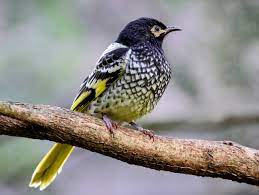- With the release of 50 conservation-bred Regent honeycreepers, the wild population of one of Australia‘s rarest birds is expected to get a new boost.
The release of the birds in Wonnarua country in the lower Hunter Valley, announced on Sunday, was the second large-scale release of conservation-bred Regent honeycreepers by the New South Wales (NSW) government.
“We are releasing conservation-bred birds to increase numbers in the wild as part of a national effort to save this critically endangered species,” said NSW Environment Minister James Griffin.
The regent honeyeater used to congregate in flocks of thousands from Queensland to southern Australia, but now only about 300 birds remain in the wild.
“We recently learned that wild regent honeyeaters are losing their song culture because there are fewer old birds than young regent honeyeaters can learn,” Griffin said.
“The ability of the regent honeyeater to sing and call is vital to attracting a mate, and the introduction of the bred birds at Taronga Zoo will give these wild birds the opportunity to learn their songs again, find a mate and ensure that the species can survive and prosper in the future.
BirdLife Australia will monitor a total of 39 birds for up to 10 weeks to see how they interact and form mixed flocks with wild birds.
“Monitoring will involve a small radio tracking team, following transmitter signals and recording the locations and behavior of individual birds to understand survival, breeding attempts and dispersal patterns,” said Mick Roderick, manager from the NSW Forest Birds program at BirdLife Australia.
With the support of a breeding programme, run by Taronga Conservation Society Australia, BirdLife Australia and the NSW Government’s Saving our Species programme, almost 600 regent honeycreepers have been bred at Taronga Zoo Sydney and Taronga Western Plains Zoo since 2000. .
To help zoo-raised regent honeyeaters learn the “love song,” they will be housed in aviaries with wild adult birds so they are exposed to the wild regent honeyeater song prior to release. ■
(Xinhua)
